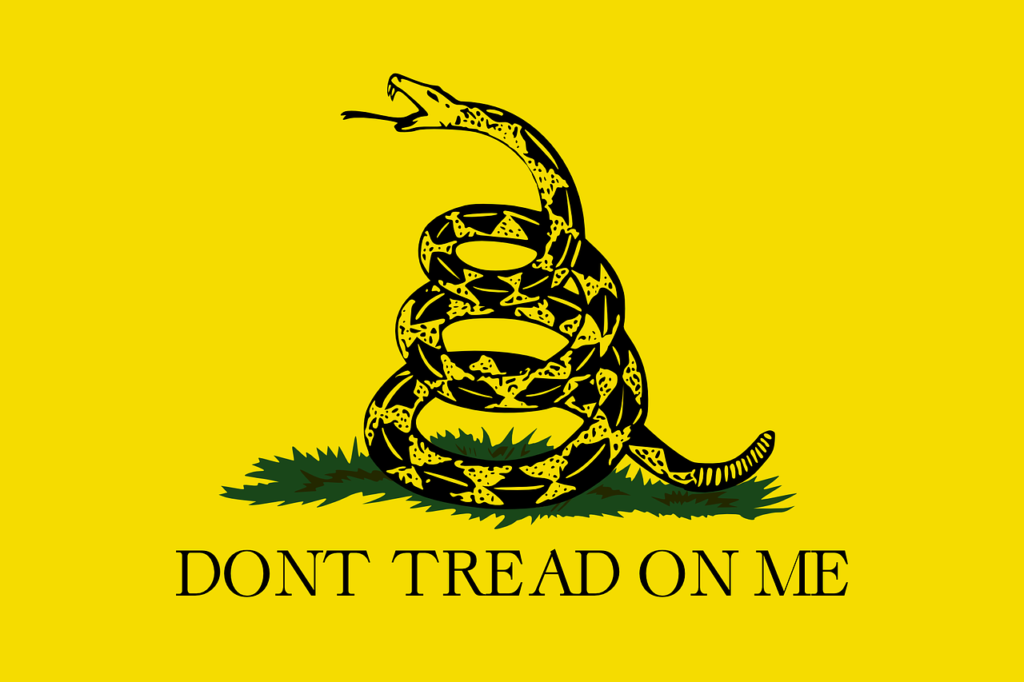The Gadsden Flag Posted by Gary Locke on Oct 15, 2020 in Culture, News
The United States is a country with many official flags on display across the land. But one flag, historically among the oldest, has had a fascinating and increasingly controversial history. This is the story of the Gadsden flag.
Beyond the traditional American flag with its red and white stripes and the white stars on a field of blue, every state and territory has its own official flag. Every branch of the military and every official cabinet office has at least one flag, There are city and county flags, and even official flags for three uninhabited islands. There are Native American tribal flags, maritime flags, and flags of district services, such as some police departments. Some Americans also choose to fly flags of historical significance. The Gadsden flag falls into this category. But it’s not that simple.
The War of Independence
The Gadsden flag was designed by Christopher Gadsden in 1775, at the height of the Revolutionary War. It has a yellow field depicting a coiled rattlesnake threatening to strike. Below the symbol of the snake are the words, Don’t Tread On Me. If it looks intimidating, that was its intention. Early American patriots flew the flag as a sign of their opposition to the British occupying forces as if to dare the British to cause trouble for anyone who lived in a house displaying that flag.
Because the rattlesnake could be found throughout the colonial territories, it was as identifiable as the bald eagle. Benjamin Franklin suggested that, if the British King continued to send dangerous criminals to the American colonies instead of to prison in England, then the colonists should thank the king by sending him live rattlesnakes. Thus, the rattlesnake became a recognized symbol of defiance in the War for Independence.
When George Washington became the Commander in Chief of all Continental Forces, he commissioned seven ships as the first Navy. Gadsden was a Colonel in this new Navy, and he presented his flag to the Commodore of the Navy to be used as the masthead for his flagship. Gadsden also presented the flag to the Congress of his home state of South Carolina. When the British captured Charleston, South Carolina during the war, Gadsden was taken prisoner, serving 42 weeks in solitary confinement.
In time, Gadsden returned to South Carolina and rebuilt his family’s business. He was a slave trader. And this is where the story pivots.
The Flag’s Resurgence
Outside of South Carolina, Gadsden’s flag mostly faded into obscurity. Historical collectors and some military aficionados kept the design alive, but to the vast majority of Americans, Don’t Tread On Me was likely only something that came up as an answer in a history quiz.
However, because Gadsden’s flag was historically the first American flag of the U.S. Navy, it came into popular use again in 1976 during the Bicentennial celebrations honoring the nation’s Declaration of Independence. Soon, the symbolic flag found acceptance among people who championed the rights of the individual over government. Libertarianism, a political philosophy that takes individual liberty to be the primary political value embraced the flag, as did the politically conservative Tea Party movement.
As the flag became a popular symbol for conservative politics, the history of the flag’s designer became better known. In some circles, it became a symbol against the policies of Barack Obama, the nation’s first Black president. In time, Gadsden’s flag was appropriated by some as an alternative to the Confederate flag, which is now banned from public display in most parts of the country.
In 2014, two police officers in Las Vegas were murdered by white extremists, and their bodies were covered by a replica of Gadsden’s flag. A Black firefighter in New Haven successfully sued to have the flag removed from his station, calling it a symbol of intimidation.
Yes, sometimes the Gadsden flag is displayed for historical purposes. But, sometimes, the flag is being appropriated for its original purpose – to once again send a message of hate and defiance.

Build vocabulary, practice pronunciation, and more with Transparent Language Online. Available anytime, anywhere, on any device.




